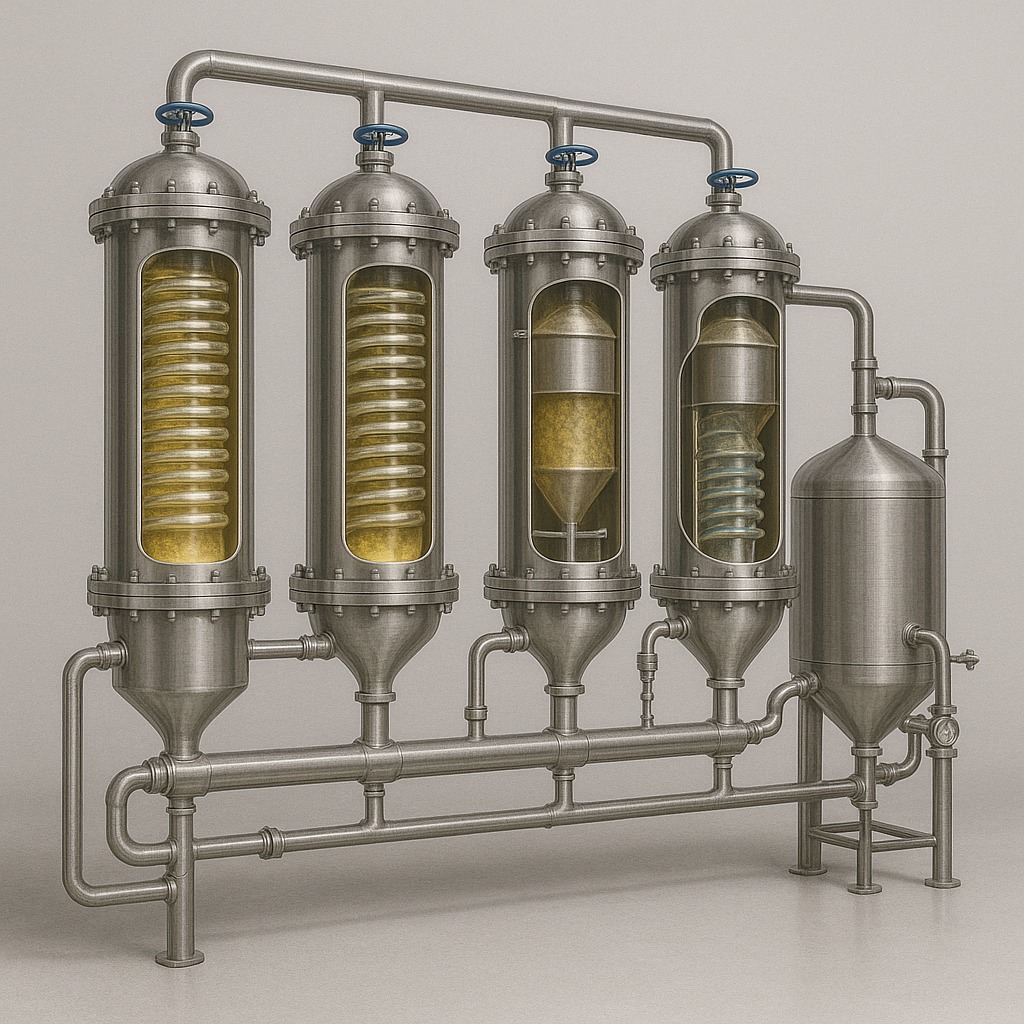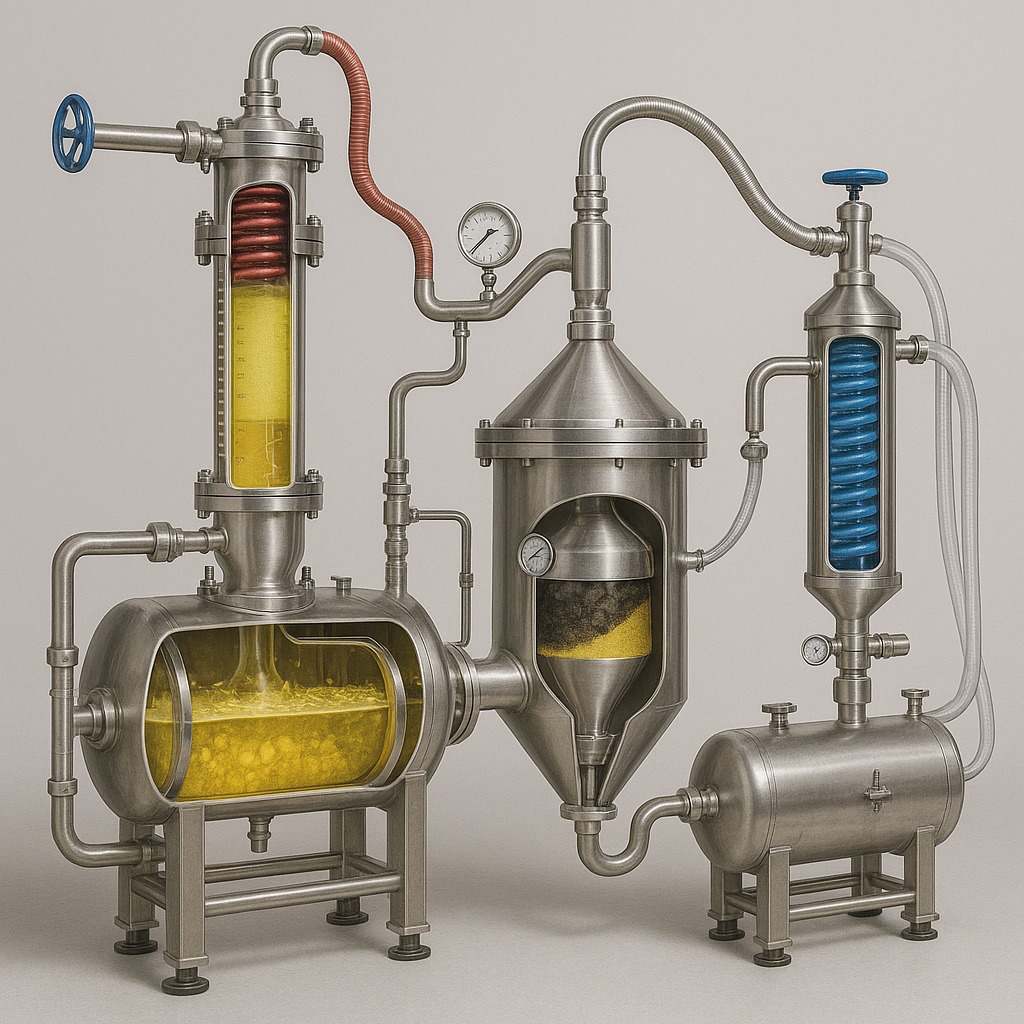Distillation
"Understanding the Criticality of Chemistry "
Distillation Columns and Strippers
Generally ‘Distillation columns’ are used to separate liquid and vapor mixtures into component fractions of desired or aimed purity, by the application and removal of heat. Over the years, Chem Process Systems has been a leader in the Design, Engineering and Manufacture of a number of distillation columns to its customers in a variety of industries, including chemical and petroleum. Distillation columns are widely used in the chemical process industries where large quantities of liquids have to be distilled.
When it comes to the word ‘Stripper’, it generally operates on the same or similar principle of operations on the application changes to a limited volume and where fractioning is limited to a specific product or single product. This is generally an aqueous or water based operations, where the Volatile compounds are evaporated with the provision of heat in a controlled environment to remove distillate, generally used in Pharmaceutical and Agro industries (but definitely not limited to)
Chem Process Systems provides an extensive range of materials and diameters for its distillation / Stripper columns, based on the particular process parameters.
Our distillation columns are of the highest quality, in construction, materials, and performance. When you’re in the market for a distillation column, consider Chem Process Systems as your problem solver.
Types Of Distillation Columns
There are many types of distillation columns, each designed to perform specific types of separations, and each design differs in terms of complexity.
One way of classifying distillation column type is to look at how they are operated. Thus we have:
Batch Columns
In batch operation, the feed to the column is introduced batch-wise. That is, the column is charged with a 'batch' and then the distillation process is carried out. When the desired task is achieved, a next batch of feed is introduced.
Continuous Columns
In contrast, continuous columns process a continuous feed stream. No interruptions occur unless there is a problem with the column or surrounding process units. They are capable of handling high throughputs and are the most common of the two types. We shall concentrate only on this class of columns.
Types of Continuous Columns
Continuous columns can be further classified according to:
The nature of the feed that they are processing,
• Binary Columns – Feed Contains Two Components
• Multi Component column - feed contains more than two components
The number of product streams they have
Multi Product Columns- Column has more than two product streams
where the extra feed exits when it is used to help with the separation,
• Extractive distillation - where the extra feed appears in the bottom product stream
• Azeotropic distillation - where the extra feed appears at the top product stream
The type of column internals
• tray column - where trays of various designs are used to hold up the liquid to provide better contact between vapour and liquid, hence better separation
• packed column - where instead of trays, 'packings' are used to enhance contact between vapour and liquid
Multi Effect Distillation

In Multi-Effect Distillation Evaporators, the upper end of the rising film evaporation tubes protrude from the upper tube plate of the calandria, so that the liquid after evaporation does not flow back into the tube and the vapor produced inside the tubes can leave the tubes without passing the liquid level on the upper tube plate. This avoids the excessive entrainment of the liquid and higher vapor and distillate salinity.
Chem Process’ Multi-Effect Distillation Evaporators have removable covers for easy accessibility to the demister pads. On the condensation side, the heating elements are designed with special internal air cooling zones which ensure optimum concentration of the non-condensable gases which are evacuated by the ejector.
Short Path Distillation – The Technology
Short Path Distillation System is generally utilized for thermal separation of thermally sensitive compounds whereby part of the product to be treated is evaporated using heat, and then it is condensed separately. Thermally sensitive Substances generally certain vitamins, flavoring agents or pharmaceutical intermediates, get damaged even at low temperatures, due to thermal decomposition, polymerization and side reactions which influences the quality of the end product.
Short Path Distillations
The Chem Process Systems Short Path Distillation systems normally operate at very low pressure ranges, and can be customized to the pressure range requirements according to the need base. The Fluid to be treated flows along the inside wall of the evaporator as a forming a liquid film. The thermal exposure time or the residence time in the equipment is very less, thus enabling minimal thermal stress. Our Unique design ensures an even distribution of liquid on the evaporator surface and ideal mixing of the product which flows downwards by the means of scrapper or wiper arrangement. This helps the more volatile substances to continuously come to the film surface and evaporate more effectively.
The salient feature of this system is the positioning of the internal condenser which condenses the vapors, hence generating a ‘short path’ of condensation and hence the distillation, and this can be achieved at very low pressures too.
The applications of this versatile equipment are spread across in the fields of :
- Oils and Fats
- Fish Oil
- Food Industries
- Polymers
- Bio-fuels or Bio-diesel
- Pharmaceuticals
- Specialty Chemicals
- A range of product based upon its processing capacity can be designed and manufactured to cater to requirements ranging from 5kg/hr upto 5000 kg/hr
- Modular and ready to install plants
- Customized solutions for batch operations and continuous operations
- Complete Automation to the discretion of our client

